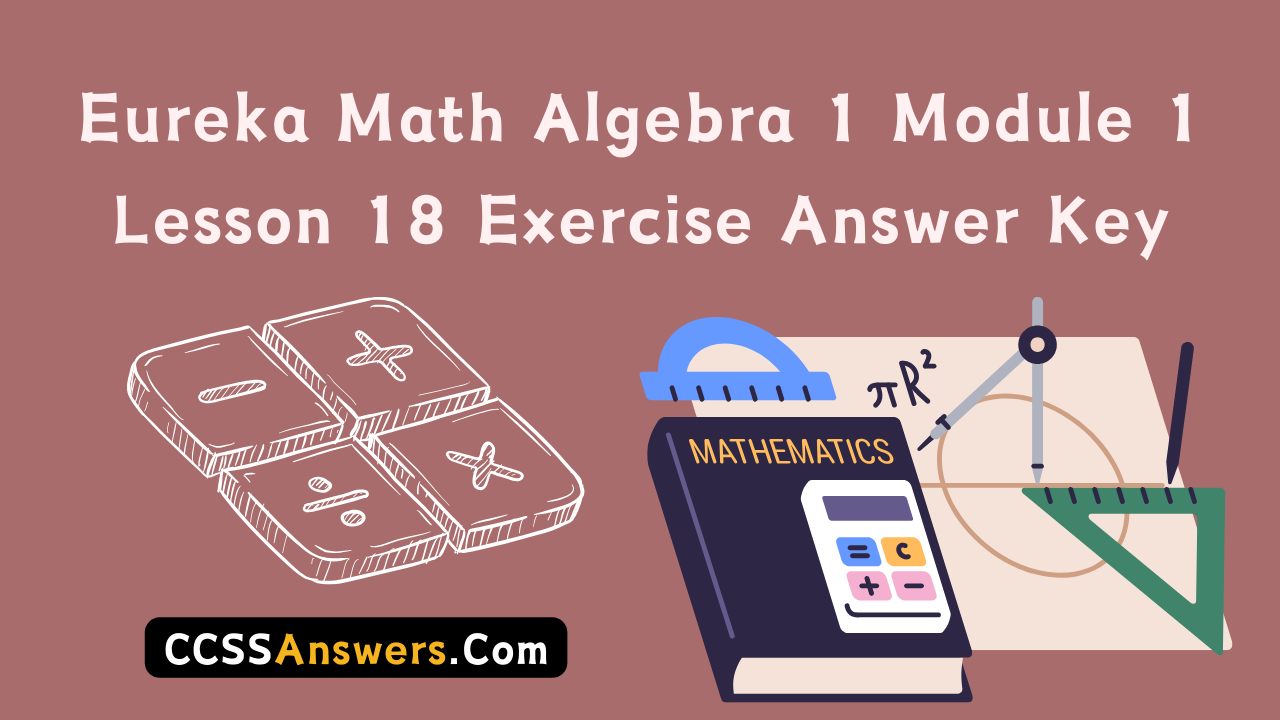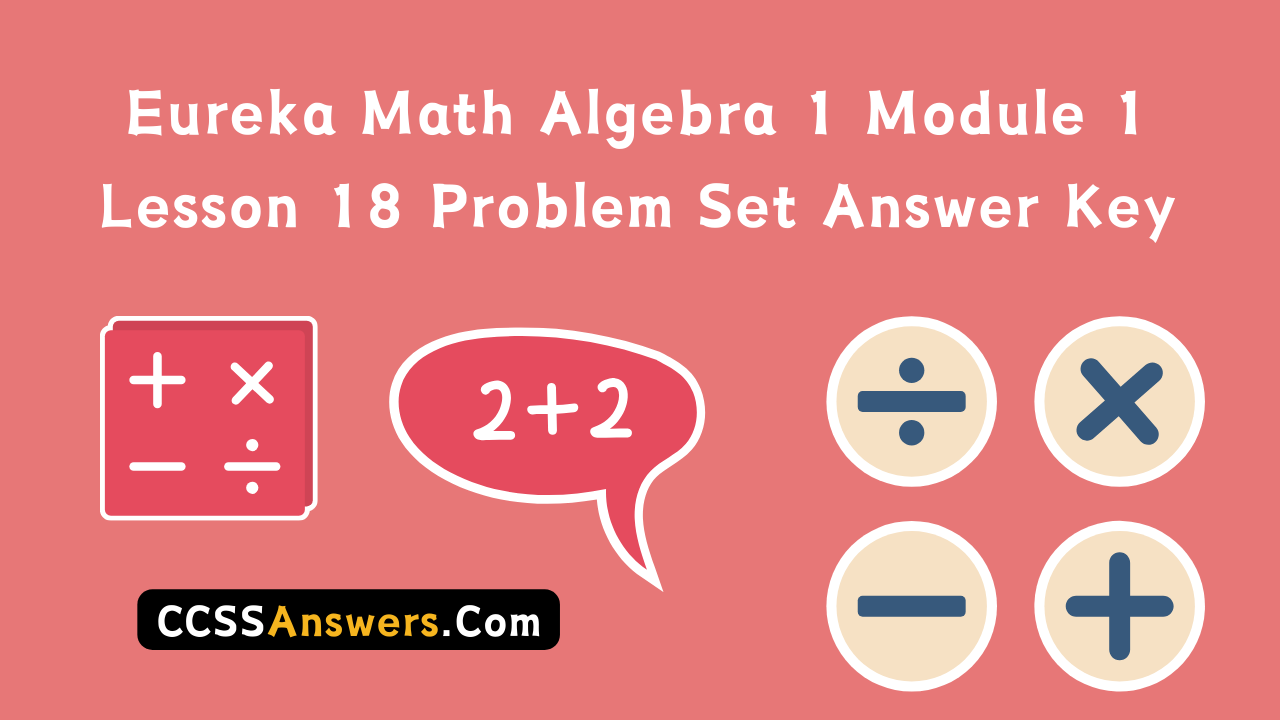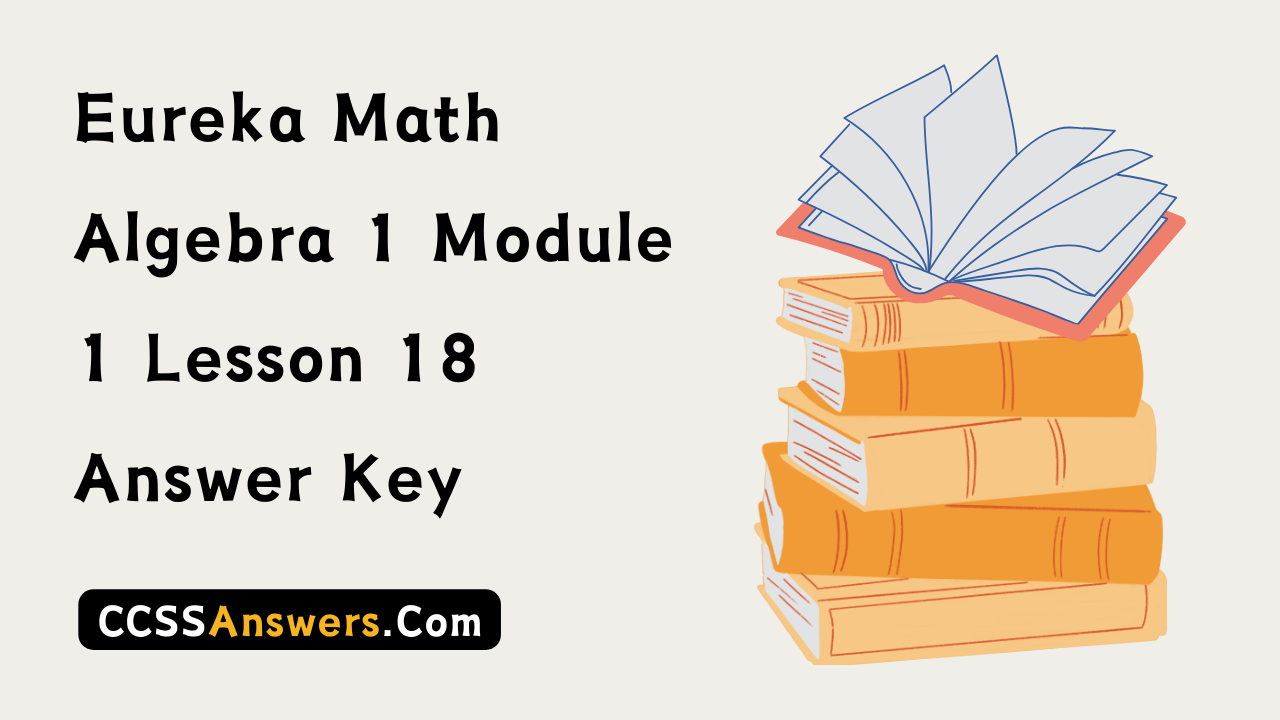Engage NY Eureka Math Algebra 1 Module 1 Lesson 18 Answer Key
Eureka Math Algebra 1 Module 1 Lesson 18 Example Answer Key
Examples 1–2
Work through the examples as a whole class.
Example 1.
Consider the equation \(\frac{1}{x}\)=\(\frac{3}{x-2}\).
a. Rewrite the equation into a system of equations.
Answer:
\(\frac{1}{x}\)=\(\frac{3}{x-2}\) and x≠0 and x≠2
b. Solve the equation for x, excluding the value(s) of x that lead to a denominator of zero.
Answer:
x=-1 and x≠0 and x≠2 Solution set: {-1}
Example 2.
Consider the equation \(\frac{x+3}{x-2}\)=\(\frac{5}{x-2}\).
a. Rewrite the equation into a system of equations.
Answer:
\(\frac{x+3}{x-2}\)=\(\frac{5}{x-2}\) and x≠2
b. Solve the equation for x, excluding the value(s) of x that lead to a denominator of zero.
Answer:
x=2 and x≠2 Solution set: ɸ
Emphasize the process of recognizing a rational equation as a system composed of the equation itself and the excluded value(s) of x. For Example 1, this is really the compound statement:
\(\frac{1}{x}\)=\(\frac{3}{x-2}\) and x≠0 and x-2≠0
→ By the properties of equality, we can multiply through by nonzero quantities. Within this compound statement, x and x-2 are nonzero, so we may write x-2=3x and x≠0 and x-2≠0, which is equivalent to -2=2x and x≠0 and x≠2.
→ All three declarations in this compound statement are true for x=-1. This is the solution set.
In Example 2, remind students of the previous lesson on solving equations involving factored expressions. Students will need to factor out the common factor and then apply the zero-product property.
→ What happens in Example 2 when we have x=2 and x≠2? Both declarations cannot be true. What can we say about the solution set of the equation?
→ There is no solution.
Eureka Math Algebra 1 Module 1 Lesson 18 Exercise Answer Key

Opening Exercise
Nolan says that he checks the answer to a division problem by performing multiplication. For example, he says that
20÷4=5 is correct because 5×4 is 20, and \(\frac{3}{\frac{1}{2}}\)=6 is correct because 6×\(\frac{1}{2}\) is 3.
a. Using Nolan’s reasoning, explain why there is no real number that is the answer to the division problem
5÷0.
Answer:
There is no number n such that 0×n=5.
b. Quentin says that \(\frac{0}{0}\)=17. What do you think?
Answer:
While it is true that 0×17=0, the problem is that by that principle \(\frac{0}{0}\) could equal any number.
c. Mavis says that the expression \(\frac{3 x-6}{x-2}\) has a meaningful value for whatever value one chooses to assign to x. Do you agree?
Answer:
No. The expression does not have a meaningful value when x=-2.
d. Bernoit says that the expression \(\frac{3 x-6}{x-2}\) always has the value 3 for whichever value one assigns to x. Do you agree?
Answer:
The expression does equal 3 for all values of x except x=2.
Note that the problem with \(\frac{0}{0}\) is that too many numbers pass Nolan’s criterion! Have students change 17 to a different number. It still passes Nolan’s multiplication check. Like \(\frac{5}{0}\), it is a problematic notion. For this reason, we want to disallow the possibility of ever dividing by zero.
Point out that an expression like \(\frac{5}{x+2}\) is really accompanied with the clause “under the assumption the denominator is not zero.” So, \(\frac{5}{x+2}\) should be read as a compound statement:
\(\frac{5}{x+2}\) and x+2≠0 OR \(\frac{5}{x+2}\) and x≠-2
Exercises 1–2
Give students a few minutes to complete the problems individually. Then, elicit answers from students.
Exercise 1.
Rewrite \(\frac{10}{x+5}\) as a compound statement.
Answer:
\(\frac{10}{x+5}\) and x≠-5
Exercise 2.
Consider \(\frac{x^{2}-25}{\left(x^{2}-9\right)(x+4)}\).
a. Is it permissible to let x=5 in this expression?
Answer:
Yes. \(\frac{0}{144}\)=0
b. Is it permissible to let x=3 in this expression?
Answer:
No. –\(\frac{16}{0}\) is not permissible.
c. Give all the values of x that are not permissible in this expression.
Answer:
x≠-3, 3, -4
Exercises 3–11
Allow students time to complete the problems individually. Then, have students compare their work with another student. Make sure that students are setting up a system of equations as part of their solution.
Work through Exercises 11 as a class.
Exercises 3–11
Rewrite each equation into a system of equations excluding the value(s) of x that lead to a denominator of zero; then, solve the equation for x.
Exercise 3.
\(\frac{5}{x}\)=1
Answer:
\(\frac{5}{x}\)=1 and x ≠ 0
{5}
Exercise 4.
\(\frac{1}{x-5}\)=3
Answer:
\(\frac{1}{x-5}\)=3 and x ≠ 5
{\(\frac{16}{3}\)}
Exercise 5.
\(\frac{x}{x+1}\)=4
Answer:
\(\frac{x}{x+1}\)=4 and x ≠ -1
{-\(\frac{4}{3}\)}
Exercise 6.
\(\frac{2}{x}\)=\(\frac{3}{x-4}\)
Answer:
\(\frac{2}{x}\)=\(\frac{3}{x-4}\) and x≠0 and x≠4
{-8}
Exercise 7.
\(\frac{x}{x+6}\)=-\(\frac{6}{x+6}\)
Answer:
\(\frac{x}{x+6}\)=-\(\frac{6}{x+6}\) and x≠-6
No solution
Exercise 8.
\(\frac{x-3}{x+2}\)=0
Answer:
\(\frac{x-3}{x+2}\)=0 and x≠-2
{3}
Exercise 9.
\(\frac{x+3}{x+3}\)=5
Answer:
\(\frac{x+3}{x+3}\)=5 and x≠-3
No solution
Exercise 10.
\(\frac{x+3}{x+3}\)=1
Answer:
\(\frac{x+3}{x+3}\)=1 and x≠-3
All real numbers except -3
Exercise 11.
A baseball player’s batting average is calculated by dividing the number of times a player got a hit by the total number of times the player was at bat. It is expressed as a decimal rounded to three places. After the first 10 games of the season, Samuel had 12 hits off of 33 at bats.
a. What is his batting average after the first 10 games?
Answer:
\(\frac{12}{33}\)≈0 .364
b. How many hits in a row would he need to get to raise his batting average to above 0.500?
Answer:
\(\frac{12+x}{33+x}\)>0.500
x>9
He would need 10 hits in a row to be above 0.500.
c. How many at bats in a row without a hit would result in his batting average dropping below 0.300?
Answer:
\(\frac{12}{33+x}\)<0.300 x > 7
If he went 8 at bats in a row without a hit, he would be below 0.300.
Ask:
→ What was the difference between Exercises 9 and 10? How did that affect the solution set?
Eureka Math Algebra 1 Module 1 Lesson 18 Problem Set Answer Key

Question 1.
Consider the equation \(\frac{10\left(x^{2}-49\right)}{3 x\left(x^{2}-4\right)(x+1)}\) =0. Is x=7 permissible? Which values of x are excluded? Rewrite as a system of equations.
Answer:
Yes, x=7 is permissible. The excluded values are 0, ±2, and -1. The system is \(\frac{10\left(x^{2}-49\right)}{3 x\left(x^{2}-4\right)(x+1)}\) =0 and x≠0 and x≠-2 and x≠-1 and x≠2.
Question 2.
Rewrite each equation as a system of equations excluding the value(s) of x that lead to a denominator of zero. Then, solve the equation for x.
a. 25x=\(\frac{1}{x}\)
Answer:
System: 25x=\(\frac{1}{x}\) and x≠0; solution set: {±\(\frac{1}{5}\)}
b. \(\frac{1}{5x}\)=10
Answer:
System: \(\frac{1}{5}\)x=10 and x≠0; solution set: {\(\frac{1}{5}\)0}
c. \(\frac{x}{7-x}\)=2x
Answer:
System: \(\frac{x}{7-x}\)=2x and x≠7; solution set: {0,\(\frac{13}{2}\)}
d. \(\frac{2}{x}\)=\(\frac{5}{x+1}\)
Answer:
System: \(\frac{2}{x}\)=\(\frac{5}{x+1}\) and x≠-1 and x≠0; solution set: {\(\frac{2}{3}\)}
e. \(\frac{3+x}{3-x}\)=\(\frac{3+2x}{3-2x}\)
Answer:
System: \(\frac{3+x}{3-x}\)=\(\frac{3+2x}{3-2x}\) and x≠3/2 and x≠3; solution set: {0}
Question 3.
Ross wants to cut a 40-foot rope into two pieces so that the length of the first piece divided by the length of the second piece is 2.
a. Let x represent the length of the first piece. Write an equation that represents the relationship between the pieces as stated above.
Answer:
\(\frac{x}{40-x}\)=2
b. What values of x are not permissible in this equation? Describe within the context of the problem what situation is occurring if x were to equal this value(s). Rewrite as a system of equations to exclude the value(s).
Answer:
40 is not a permissible value because it would mean the rope is still intact. System: \(\frac{x}{40-x}\)=2 and x≠40
c. Solve the equation to obtain the lengths of the two pieces of rope. (Round to the nearest tenth if necessary.)
Answer:
First piece is \(\frac{80}{3}\)≈26.7 feet long; second piece is 40/3≈13.3 feet long.
Question 4.
Write an equation with the restrictions x≠14, x≠2, and x≠0.
Answer:
Answers will vary. Sample equation: \(\frac{1}{x}\)(x-2)(x-14) =0
Question 5.
Write an equation that has no solution.
Answer:
Answers will vary. Sample equation: \(\frac{1}{x}\)=0
Eureka Math Algebra 1 Module 1 Lesson 18 Exit Ticket Answer Key
Question 1.
Rewrite the equation \(\frac{x-2}{x-9}\)=2 as a system of equations. Then, solve for x.
Answer:
\(\frac{x-2}{x-9}\)=2 and x ≠ 9
x-2=2(x-9)
x-2=2x-18
16=x
{16}
Question 2.
Write an equation that would have the restriction x≠-3.
Answer:
Sample answer: \(\frac{4}{x+3}\)=2
